First we saw one of the handsome parents, and then we saw the long-legged fluffball: a baby spotted dikkop. How special to see the caring and attention lavished on this precious little chick.
Both parents were in attendance with one staying with the chick, often settling down onto the ground and allowing the chick to burrow into its breast feathers, while the other parent caught prey – rather successfully it seemed as it returned several time to regurgitate its catch to feed the baby.
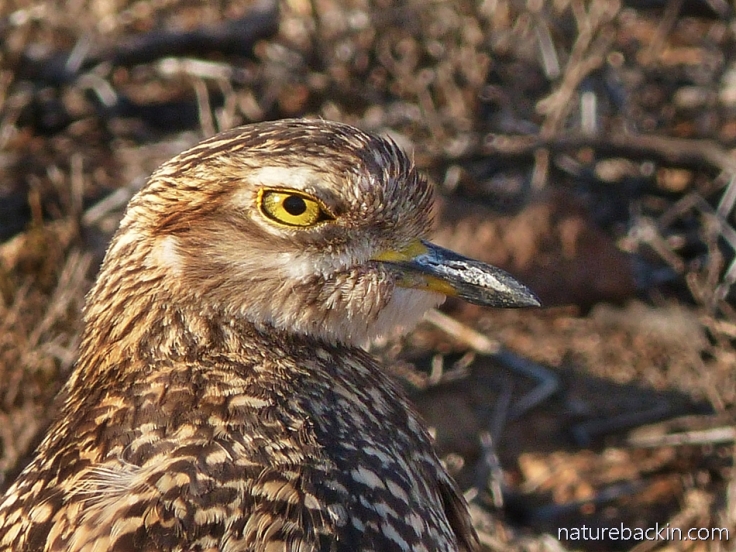
The parent bird first seen in the bright glow of the late afternoon sunshine
The previous English name, spotted dikkop, has been changed as part of a process of standardising common names for birds globally, and so it should now be called spotted thick-knee. In Afrikaans it is still known as the gewone dikkop, that is the common dikkop – literally dikkop means thick or fat head, referring to the relatively large head of this bird. Its scientific name is Burhinus capensis. Species of thick-knee birds are also known as stone-curlews.
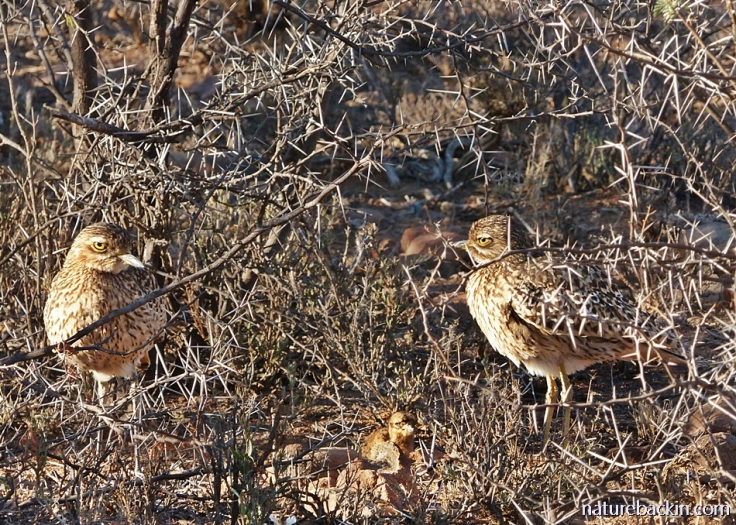
Perhaps this photo conveys just how hard it was to see the well camouflaged baby bird through the skimpy dry vegetation. When the second parent approached the tiny chick stood up and showed itself – it can just be seen in the centre foreground of this photo
We saw this little family on our recent visit to the Camdeboo National Park in the Eastern Cape. We stopped the car on the side of road and sat quietly and watched the birds for about half an hour – it was definitely one of the highlights of our visit.
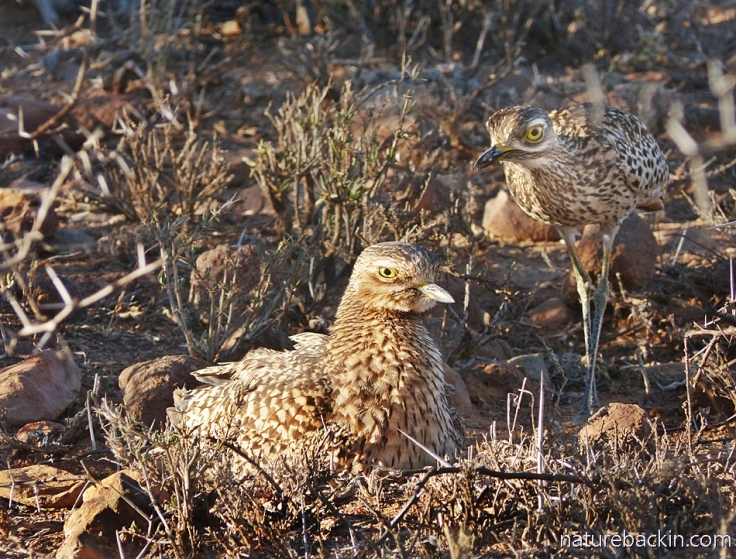
The one parent is settled down with the baby concealed in its breast feathers. The other parent approaches after a successful hunt ready to feed its catch to the baby
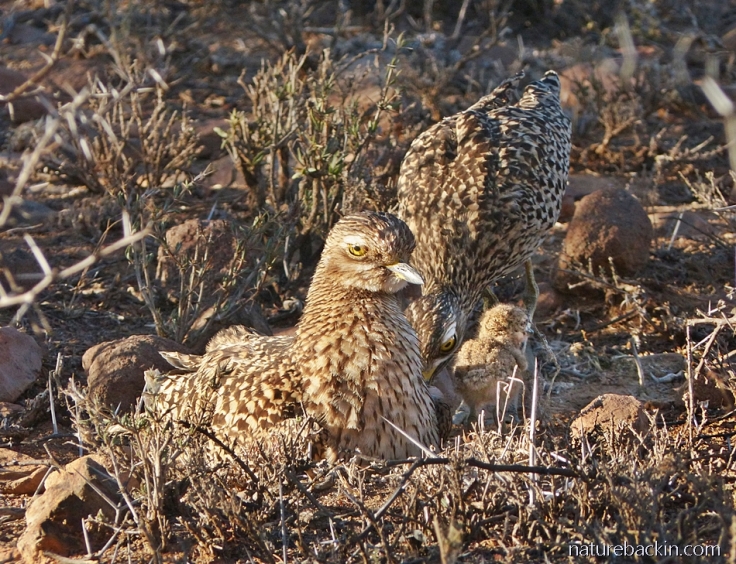
The baby emerged so it could be fed. The actual feeding was done behind the parent that remained squatting on the ground with its legs folded under it. From what we could see, the parent doing the feeding regurgitated its catch for the baby
Spotted thick-knees feed mostly on insects, but also eat small animals such as small rodents, lizards, frogs and molluscs, as well as eating grass seeds. Both parents share in raising the young. There may be 1-3 eggs in a clutch, and the parents take turns incubating the eggs in a nest that is little more than a scrape in the ground, although it may be lined with twigs, leaves, feathers and other materials. The nesting site is usually near a bush but with a good all-round view. Parents vigorously protect their young and may use threat displays or give chase to intruders. They may also feign injury such as a broken wing in order to draw a predator or threat away from the eggs or the fledglings.

The youngster showing its long legs (and thick “knees”) while it stands close to its parent
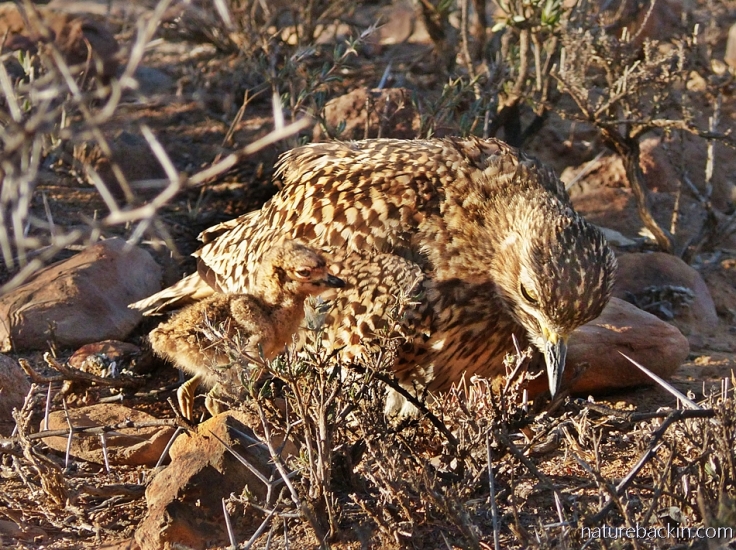
The chick seemed to enjoy the warming rays of the sun, although several times it burrowed into the safety of its parent’s breast feathers, with just its legs sticking out
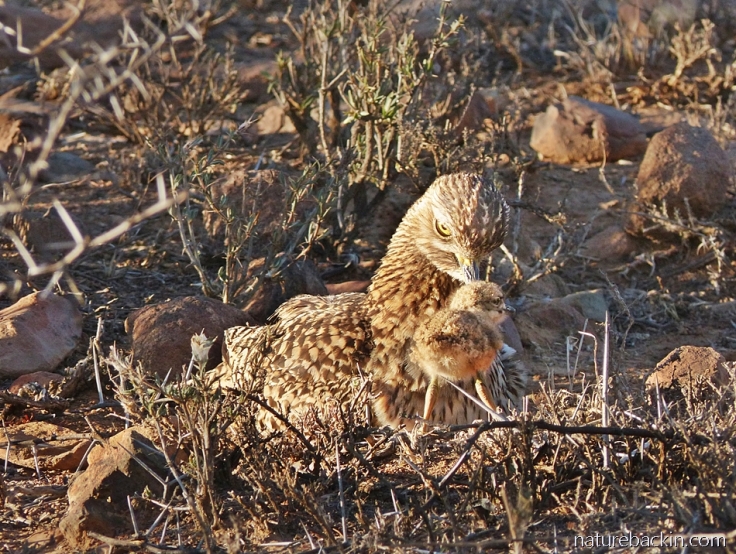

Is it anthropomorphic to think that a real affection is shared between baby and parent?
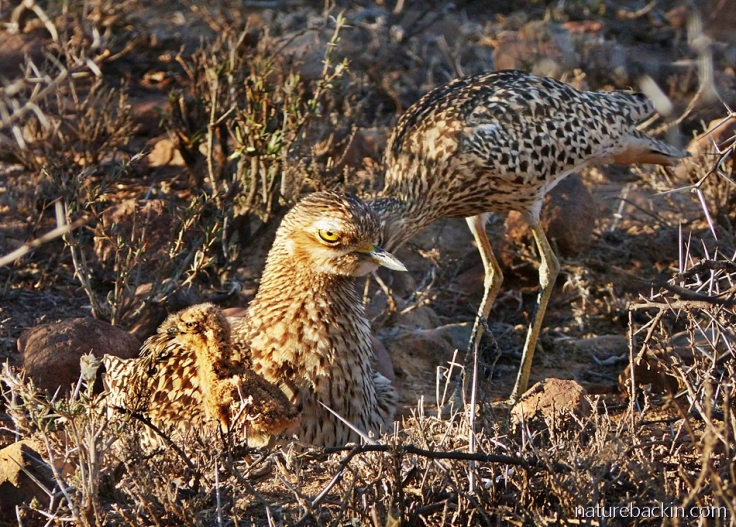
Raising one chick is hard work – how much harder when they raise two or even three? Spotted thick-knees may double-brood or even triple-brood within one breeding season
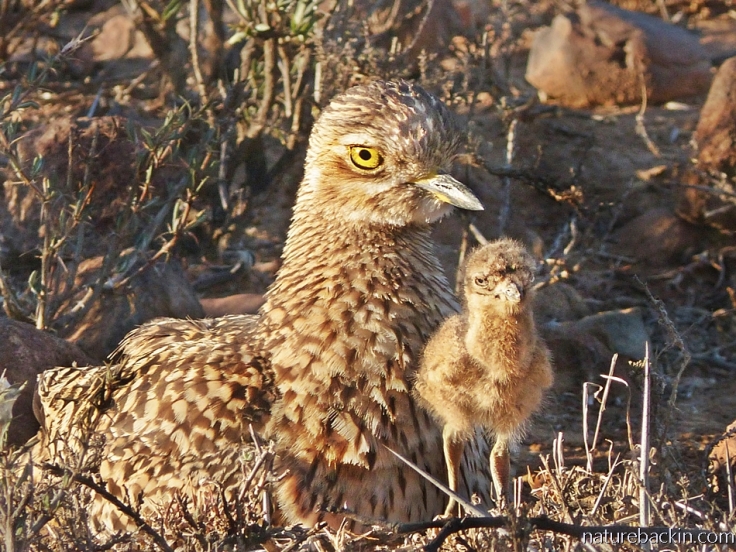
The birds seemed relaxed in our presence – we were a fair distance away and they were partially screened by small dry thorn bushes
Spotted thick-knees are mostly nocturnal, but they are also crepuscular – a gorgeous word meaning that they are active in the twilight hours of dusk and dawn. They may also be active on overcast days.

As the sun dipped lower the baby became more active, venturing further away from its parents who made an effort to keep up with it. Rather reluctantly we left them. This is our last photo of them before we drove away
Despite being on the “wrong” side of the car and the difficult light and intervening vegetation, my husband managed to shoot some video clips of the spotted thick-knee chicks and its parents
I thought that this baby bird makes a suitable emblem for the New Year that is about to fledge. Wishing you all good things for the New Year and may hope spread its wings and fly.
Posted by Carol

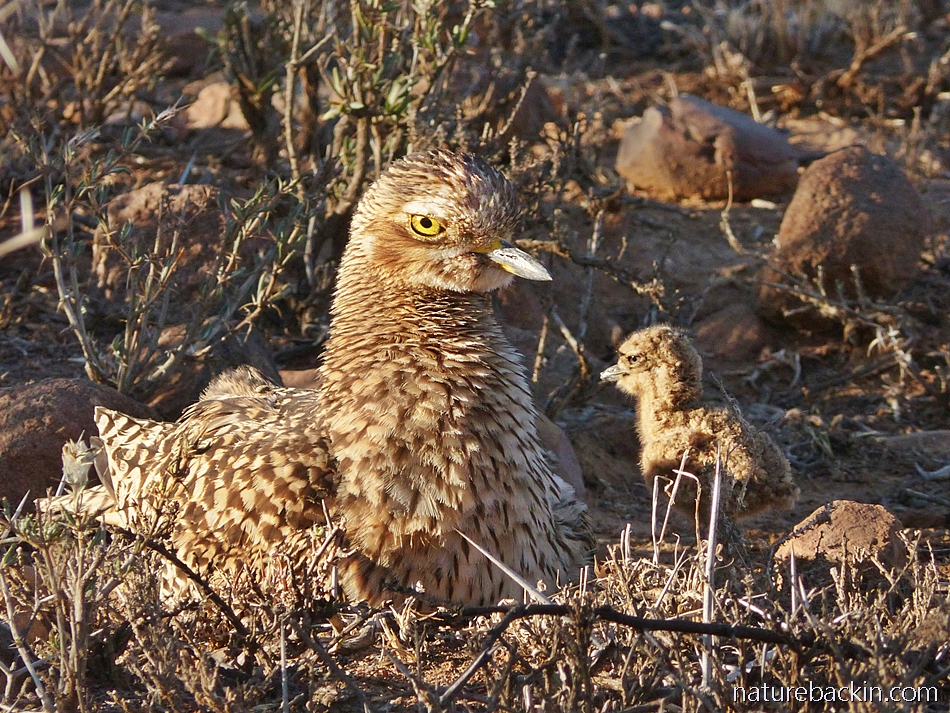







January 15, 2020 at 2:17 am
Such a lovely feature again, Carol!
My mother is blessed to have a pair of Spotted Thick-knees use her garden as their home for a couple of years already, and every year we all take great joy in watching the entire breeding process from the laying of the eggs to the chicks eventually becoming independent.
LikeLiked by 1 person
January 15, 2020 at 8:18 pm
How lovely that your mother and your family can share in the joy of watching the birds raise their young each year.
LikeLiked by 1 person
January 15, 2020 at 1:18 am
I love your photos. I do see a real affection, innocence, curiosity, and trust in the sweet expressions of the baby spotted dikkop. No matter what species, the responsibilities of raising a child are profoundly complex. You captured something essential about that. And you gave me a cool new word: crepuscular!
LikeLiked by 1 person
January 15, 2020 at 8:16 pm
It is hard not to be moved when witnessing such bonds between parents and child. I am pleased that you also like the word “crepuscular”!
LikeLiked by 1 person
December 30, 2019 at 9:29 am
I have missed reading your posts for a few weeks, Carol, but what a beautiful post I have come back to 🙂 Such delightful birds, exquisitely captured in simplicity, clarity and calm. I share your message of hope spreading its wings in the coming year and I am also reminded that beneath the turmoil and noise created by the human condition, life continues. Long may the spotted thick-knees remind us of what’s truly important.
Blydhen Nowydh Da Dhis! (Happy New Year to you!)
LikeLiked by 1 person
December 30, 2019 at 1:57 pm
Hallo Sandra and thanks very much for the New Year good wishes (in Cornish I assume?). Happy New Year to you too, and yes the birds do serve to remind us what really is important …
LikeLiked by 1 person
December 27, 2019 at 6:57 pm
Strikingly beautiful pictures
LikeLiked by 1 person
December 28, 2019 at 10:01 am
Thank you Edith. They are most striking birds!
LikeLike
December 27, 2019 at 6:46 pm
Beautiful photos and a wonderful and touching narrative. What a special message for the new year
LikeLiked by 1 person
December 28, 2019 at 10:12 am
Thank you so much. Baby animals do carry a lot of hope …
LikeLiked by 1 person
December 27, 2019 at 5:19 pm
Marvelous post Carol, and Kudos to hubby for the video.
Very occasionally we get a visit to the garden from this bird,which is heard but rarely seen. However, I did manage a couple of (poor ) photos on one visit.
LikeLiked by 1 person
December 28, 2019 at 9:58 am
Thanks Ark. Nice that you get the occasional visit. We are a bit too well wooded to get them here, but I have seen a nesting pair on a piece of open ground in an adjacent suburb.
LikeLike
December 27, 2019 at 4:40 pm
I looked at the first photo and thought “that reminds me of a stone curlew” – so thank you for confirming. We have one species of stone curlew in the UK but it is extremely rare here now, yet another victim of modern farming methods.
Lovely family portraits here.
LikeLiked by 1 person
December 28, 2019 at 8:19 am
It was only when reading for the post that I learned about the term ‘stone curlew’. So sad that the UK stone curlew is now rare. The spotted thick-knees in South Africa too fall victim to agriculture and also stock farming. It seems it is their wide distribution across most of sub-Saharan Africa (with the exception of the West and Central African forested regions) that partly contributes to the population being regarded as stable. In some places they have adapted to suburban areas with some gardens hosting breeding pairs.
LikeLiked by 1 person
December 27, 2019 at 1:13 pm
Challenge, reread this blog imagining yourself an alien sitting on a star with a telescope facing your house and the birds are you, your husband and child…after you gave birth. It becomes super interesting what the alien writes.
Enjoyed thank you
LikeLiked by 1 person
December 27, 2019 at 1:41 pm
Ja, I wonder what alienmorphic attributes the ET might ascribe to us parents and child? Maybe though, in actuality we really are being monitored by a Big Brother/Data Harvester closer to home than a star?
LikeLike
December 27, 2019 at 2:06 pm
Maybe.
LikeLiked by 1 person
December 27, 2019 at 2:22 pm
🙂
LikeLike
December 27, 2019 at 12:18 pm
Awesome pictures and such a lovely description of every picture, Carol. Thanks for this lovely share.
LikeLiked by 1 person
December 27, 2019 at 1:20 pm
Thank you Kamal, and best wishes for the year ahead.
LikeLike
December 27, 2019 at 2:53 pm
Welcome Carol and same to you too dear.
LikeLiked by 1 person
December 27, 2019 at 11:24 am
Another one of those moments where the fear of anthropomorphism intrudes while you instinctually resonate with dynamics that are supposedly only reserved for humans. Observing this family communicate with each other in a universal language only made me question how separate humans really are from the “others”. Love the images and text Carol. “Anthropomorphism:
Ascription of human shape or qualities to nonhuman creatures or inanimate objects.”.
LikeLiked by 1 person
December 27, 2019 at 12:12 pm
Thanks so much and it is great that you were with us to share in this experience. Thanks for the definition of anthropomorphism – I was not aware that it could be ascribed too to inanimate objects, as if inanimate objects and “nonhuman creatures” are in the same class, rather than that all creatures (human and nonhuman) are in fact more closely related and similar in so many ways …
LikeLike
December 27, 2019 at 9:06 am
Oh oh. What a heartwarming and beautifully documented story. An insightful message for this time of the year. Thank you Carol
LikeLiked by 1 person
December 27, 2019 at 12:04 pm
Thank you Mariss – these birds are living in such hard times, and their dedication in the face of all that is deeply touching. We all need all the inspiration we can get – that and rain, especially in the many regions blasted by heat and desperate for water. We are relatively privileged here where we live, and I so wish that you get decent rains before the end of summer.
LikeLiked by 1 person
December 27, 2019 at 8:22 am
Hello Carol,
What a wonderful moment! Thank you so much for sharing with us. I can’t help but feel (from my biased human emotions) that there is definite love and affection between the parents and chicks. Wishing you and your husband a wonderful 2020.
Best wishes,
Takami
LikeLiked by 1 person
December 27, 2019 at 11:57 am
Thank you so much Takami, and wishing you and your family the very best for 2020, and more opportunities to continue watching and photographing birds and other creatures and their families. Given the hours you spend observing bird families, I am pleased to hear that you also feel their love and affection for each other 🙂 Perhaps it’s we humans who have a lot to learn from them.
LikeLiked by 1 person
December 28, 2019 at 2:56 am
Thank you (again!), my husband & I appreciate your warm wishes. I’m so happy our paths crossed through photography, and sincerely look forward to sharing/learning more insights in the coming year 🙂
LikeLiked by 1 person
December 28, 2019 at 10:14 am
Me too Takami – thank you.
LikeLike
December 27, 2019 at 7:44 am
What an adorable little chicklet. And the video was a special treat. Wishing you and your husband a wonderful, serene new year with lots of hope fulfilled!
LikeLiked by 1 person
December 27, 2019 at 11:53 am
Indeed the little bird really is adorable – no wonder the parents are so doting 🙂 Lovely to have some video of them. Thanks so much for the kind good wishes. Wishing the same to you and to Eric for the year ahead, and of course also more rain. I hope that you are feeling properly rested and better and that your computer problem solving is progressing well.
LikeLike
December 27, 2019 at 6:53 am
What a delightful and interesting post and video, with its optimistic new year message. All good wishes to you too, Carol, and please keep posting from your garden and beyond.
LikeLiked by 1 person
December 27, 2019 at 11:41 am
Thanks Margaret. Goodwill and optimism are surely better than the alternatives! Best wishes to you and your family too, and thanks for the blogging encouragement, which I really appreciate. I hope that you keep on posting too, its such a lovely way to make connections 🙂
LikeLiked by 1 person
December 27, 2019 at 1:31 pm
Isn’t it just? I never knew I was interested in South African wildlife till I ‘met’ you.
LikeLiked by 1 person
December 27, 2019 at 1:49 pm
And I have enjoyed yomping in the countryside in parts of Yorkshire, France and Spain with you, and much else besides. (I hope I got that right – it is indeed yomping?)
LikeLiked by 1 person
December 27, 2019 at 6:42 am
Wonderful crisp images of these interesting birds, Carol. So sweet to see how protective of their little one. Surprised to see how long their legs are. Enjoyed your well written narrative and your apt analogy of fledglings and the New Year. Wishing you many happy adventures in 2020! 🌈🌟
LikeLiked by 1 person
December 27, 2019 at 11:38 am
Thanks Jane. They are intriguing birds and lovely to watch. Let’s hope the New Year brings good things for young and old and that going forward sentiment and action swing more in favour of protecting our wonderful planet – which you document so superbly with your camera. WIth very best wishes to you and yours for the year ahead.
LikeLike
December 27, 2019 at 6:09 am
Lovely photos and story. The bird looks like a heftier version of the Pacific golden plover we get here. It has similar looking plumage and also blends in to scrubby ground like your spotted thick-knee. I particularly like the severe look of the parent in the second photo and the last photo is a great way to leave and remember them – parent and baby winding down another watchful day.
LikeLiked by 1 person
December 27, 2019 at 11:31 am
Yes they are very plover-like – even their way of running and pausing as they hunt for prey is plover-like. The parents seemed to be ever vigilant and caring. The pressures of parenthood must be quite relentless!
LikeLiked by 1 person
December 28, 2019 at 6:37 am
Yes, raising a youngster in nature is a challenge. Seeing them make it to adulthood is something of a triumph these days.
LikeLiked by 1 person
December 27, 2019 at 5:50 am
Wonderful post, many thanks Aunty Carol.
We are blessed to have a pair in our garden who have over the past 3 years had a number of babies. They are my favourite birds in the garden. Even my dogs leave them alone. Very precious to watch them running too and fro in the dusky evenings.
Have a blessed New year and may 2020 be all you hope it to be. ❤️
LikeLiked by 1 person
December 27, 2019 at 11:28 am
Thanks so much Debs. You are indeed blessed to have dikkops nesting in your garden – and successfully raising babies too.
Wishing you all a happy New Year and a wonderful year ahead ❤️
LikeLike
December 27, 2019 at 4:37 am
I am delighted to read this post for I find these birds fascinating to watch. We had a similar experience in the Addo Elephant National Park when, quite by chance – for we had stopped for something quite different – we saw a dikkop sitting on its nest RIGHT next to the road, just at the point where the roadside pebbles get a bit larger. I also came across a pair with their chick in the car park of the airport in Port Elizabeth: both seemed rather precarious places. Of course, they are much more at home in the wild, as you have photographed them. A word I came across earlier this year to describe chicks that are well-developed and able to leave the nest soon after hatching is nidifuguous – I think of dikkop chicks being able to walk around with their parents so quickly after hatching and have been looking forward to using the word. You have provided such an opportunity 🙂
LikeLiked by 2 people
December 27, 2019 at 11:24 am
Thanks Anne. Those nesting sites you saw do sound to be most precarious. Happy to help with nidifuguous! I read that dikkops are able to walk within 30 seconds of hatching 🙂
LikeLiked by 1 person
December 27, 2019 at 4:34 am
i am always amazed at how sharp and clear your photos are. well done!
LikeLike
December 27, 2019 at 11:22 am
Thanks so much Buddy. The the strong light and shade contrast, the distance, and the vegetation screening the birds were a bit of a challenge, but I was pleased to find some images showing off the cute little chick and the attentive parents 🙂
LikeLike
December 27, 2019 at 12:34 am
Such an adorable wee thing! Great presentation you two. Loved seeing the little guy in action. 😉
LikeLiked by 1 person
December 27, 2019 at 11:22 am
Thanks Eliza. That little downy baby was totally adorable. It was great to have some video of it too,
LikeLike
December 27, 2019 at 12:33 am
Carol, you took beautiful shots here. Loved reading your whole post and the way you really watched this small family with so much of patience. Camouflage effect of the birds with surroundings is really wonderful !!
LikeLiked by 1 person
December 27, 2019 at 11:04 am
Thanks so much Deeksha. That camouflage is amazing, and hopefully effective as they seem so vulnerable nesting on open ground as they do. We loved watching the little family, and I had to turn off the soundtrack on the video on account of all the oohs and aahs and “how cute is that” comments in the background 🙂
LikeLiked by 1 person
December 28, 2019 at 1:52 am
From a distance also you got really very good pictures and video in capturing their activities.
Have a wonderful weekend..
LikeLiked by 1 person
December 28, 2019 at 10:13 am
Thank you – you too.
LikeLiked by 1 person